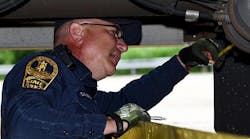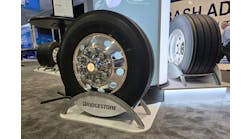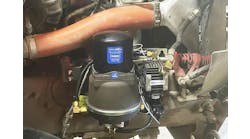Why truck inspectors devote full week to improving brake safety
The Commercial Vehicle Safety Alliance (CVSA) has set this year’s Brake Safety Week for August 22-28. Throughout the week commercial motor vehicle inspectors will focus on truck brake systems and components. Every North American Standard Inspection includes brakes, so why devote a full week to them? Let’s start with the numbers:
- During the 2020 International Roadcheck, brake adjustment violations accounted for 38.6% of all vehicle out-of-service violations, more than any other category.
- A look at the Federal Motor Carrier Safety Administration’s “Large Truck and Bus Crash Facts” shows brake systems rank as the third most cited vehicle factor in fatal crashes.
- In 2020, brake-related problems occupied eight of FMCSA’s top 20 vehicle violations.
- When CVSA conducted Brake Safety Week last year, 12% of 43,565 inspected CMVs were placed out-of-service due to braking issues.
Numbers don’t lie. But real-life stories showing the human cost of brake failure brings the message home:
- According to a 2002 National Transportation Safety Board press release, “Three school children died on May 31, 2001, when a truck-tractor semitrailer exited Interstate 540 near Mountainburg, Arkansas, failed to stop at the bottom of the ramp, and collided with a school bus. Post-accident examination showed that eight of the truck's 10 brakes were either out of adjustment or nonfunctional, with four of them unable to provide any braking force.”
- Massachusetts got more involved in brake inspections when a gravel truck went through a house.
- Connecticut took braking more seriously after a dump truck killed multiple people.
- A truck with bad brakes caused a relatively minor accident in Boston, but the resulting lawsuit led to tremendous damages against the motor carrier.
FMCSA has detailed regulations on the maintenance and inspection of brakes. Every truck driver and every motor carrier should know and understand the importance of correctly measuring pushrod stroke, among other requirements, to determine whether brakes are in adjustment. The facts, however, speak otherwise:
- Roadside inspectors often see brakes with a cage bolt holding back the parking brake spring. In an emergency, this allows a truck to be moved when there are serious air leaks and the axle brakes are not working. But a “caged brake” in regular operation is a sign that the truck operator knows the brakes are shot. Duct tape on air hoses, and clamps holding air hoses together also warn inspectors of a brake system in disrepair.
- Numerous inspections reveal front brakes that were intentionally disabled using devices such as vise grips, c-clamps, etc.
- CVSA reports that chafing of brake hoses is a growing problem, as chafing left unchecked leads to air leaks and malfunctioning brakes.
The vast majority of truckers and trucking companies want to operate safely. They want to feel they have done their job keeping our country up and running when their workday comes to a stop. To do that, their trucks must also come to a stop, safely. Brake Safety Week in August will test how well those truck brake systems are working. That leaves plenty of time to prepare for that safe conclusion to the workday.
Steve Vaughn is the vice president of field operations at PrePass Safety Alliance, the provider of PrePass weigh station bypass and toll payment/management services. Vaughn served nearly three decades with the California Highway Patrol and is a past president of the Commercial Vehicle Safety Alliance.
This article originally appeared on FleetOwner.com.



